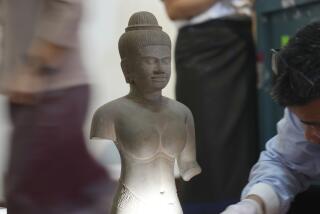Charges of theft of Tibetan art
- Share via
Seizing an opportunity to promote its long-festering cause, a Tibetan rights group has issued a statement charging that the Bowers Museum of Cultural Art in Santa Ana is displaying stolen objects in its new exhibition, “Tibet: Treasures From the Roof of the World.”
The artworks and artifacts, made for Dalai Lamas and drawn from museums in Lhasa, were loaned by the Chinese government. But the Tibet Justice Center, a Berkeley-based nonprofit organization that advocates self-determination for the people of Tibet, contends that the Chinese acquired the objects illegally when they took control of the country in 1951.
“This art belongs to the Dalai Lama and to the Tibetan people,” said center director Minnie Cancellaro, reached by telephone at her office. “Tibet is an occupied country.”
In Santa Ana, where the exhibition has attracted 3,500 visitors during its first week, museum director Peter C. Keller responded with a printed statement: “The Bowers Museum of Cultural Art signed an agreement with officials of the Tibet Autonomous Region (T.A.R.), which gave the Bowers the right to display 118 sets of objects in the United States for two years. These objects were selected by the Bowers Museum from the collections of the Potala Palace, Norbulingka, and the Tibet Museum; the premier cultural institutions in Tibet.
“Following their exhibition at the Bowers, ‘Tibet: Treasures From the Roof of the World’ will travel to the Houston Museum of Natural Science, the Rubin Museum of Art in New York, and the Asian Art Museum of San Francisco. Following its San Francisco showing, the Bowers Museum is contractually obligated to safely return the objects to their respective institutions.”
The Dalai Lama, who is in exile in India, supports exhibitions of Tibetan art if visitors have access to accurate explanatory material. Bowers officials and the exhibition’s guest curators say that he has approved the show to encourage knowledge and appreciation of Tibetan Buddhist culture.
“I wouldn’t have been involved otherwise,” said curator Robert Warren Clark, who has worked in the Dalai Lama’s offices and has written an essay in the exhibition catalog. “This is an opportunity to explain the meaning and the use of the objects for an American audience.”
More to Read
The biggest entertainment stories
Get our big stories about Hollywood, film, television, music, arts, culture and more right in your inbox as soon as they publish.
You may occasionally receive promotional content from the Los Angeles Times.










